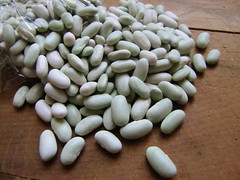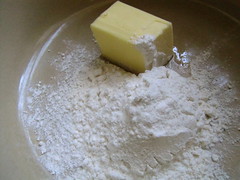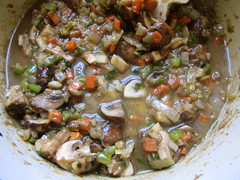
For a long time, I could never fathom making many beloved, wintry foods without meat. It seemed like if you took the meat away, you’d lose the whole hutzpah of the thing. And besides, we need something to fortify our chilled bones with. Well, it’s taken a long journey but in the case of cassoulet, I’ve decided that it isn’t the pork, or duck fat that is the whole hutzpah, it’s the tender, melt-in-your-mouth beans swaddled in a creamy, baked-in sauce.
Most meat-lovers may never come around to this determination, but stranger things have happened. In lieu of animal fat, I created a rich, dark roux as a base and peppered the whole thing with plenty of vegetables for a depth of flavor. The resulting cassoulet (yes, I’m still going to call it that) has a pleasing, sweet-savory taste and velvety mouthfeel that is quite addicting in a totally harmless way.
Is it really that non-traditional? Well, maybe not if you consider that this dish, like paella or gumbo, has very homely origins. Cassoulet, like many other types of humble, vegetable-based foods, was traditionally a repository for any scraps of meat and fat one could spare, giving the cooked beans a hearty flavor. Sausages (themselves a repository for said bits) are common to find buried among the beans, and if observing the last two years of the Greenmarket Cassoulet Cook-Off at Jimmy’s No. 43 says anything, duck fat is seen as an inseparable ingredient among modern interpreters, too.
 usual suspects: carrot, celery and parsnip
usual suspects: carrot, celery and parsnip
I know, sounds delicious, right? But I also know (from being one of those cook-off contestants, and from talking to the others) that those ingredients can jack up the cost of your cassoulet by an egregious margin. Especially when you’re making a very large portion of it, which you might as well do even when not serving a huge room, since it takes a while to cook. And that’s one area I’m not going to cut corners on — cooking it properly. There’s little attraction to “al dente” beans.
 green flageoulets, a prized bean for cassoulet
green flageoulets, a prized bean for cassoulet
How long they need to cook and how much liquid should you add varies depending on the beans. If they aren’t tender by the time you finish the recipe below, add some more cooking liquid and give it some more time. Keep in mind that if your beans are larger than the fancy, French flageoulet beans that I’m using here (or smaller, such as with Navy beans), you might need less of both. Just don’t use canned beans here; you want the beans to soak in all the flavors of the cassoulet as they cook.
 butter and flour are combined over low heat
butter and flour are combined over low heat
 half an hour later, as chestnut roux
half an hour later, as chestnut roux
Next step was developing the roux, which can be done while chopping or doing other things — just give the pot a scrape of your spatula now and then. Roux, an essential French cooking technique that gives way to all types of sauces afterwards, is just flour, butter and stirring. As the butter bubbles, the flour slightly burns, or caramelizes, to any desired depth of color (and flavor). I stopped stirring once mine had reached a deep “chestnut” brown. Its smell kind of reminds me of buttered burnt toast.
Then, it’s a matter of building flavor upon flavor. I wanted some of the vegetables in this to stand out more than others, so I cooked down my carrot-onion-celery mirepoix for quite a while before adding the next ingredient, mushrooms. I liked the idea of having chunky vegetables strewn about, so I chopped these into sizable wedges. For about half of the cooking liquid, I poured from a mason jar of fresh tomato sauce that I’d canned over the summer; cooking down a couple fresh tomatoes right into this mixture should do instead just fine. One of the last additions before popping this big pot into the oven was a couple handfuls of big chunks of raw squash. These cooked down to incredibly delicious, loose sponges of orange when it was all served up. They’re a delight to come across, and I found myself picking them all onto my plate when it was time for seconds.
If you’re not convinced after trying this recipe that it is the most incredible vegetable cassoulet you’ve ever had (or the best cassoulet of any kind), then come down and share your recipe at the 3rd Annual Cassoulet Cook-Off, on January 22. It’s a benefit for the Greenmarket, and I’ll be one of the judges this time. Don’t worry, I’ll gladly eat your pork or duck fat, if that’s what you go with!
Incredible Vegetable Cassoulet
(makes 4-6 servings)
1 cup dry beans (preferably cannellini beans or flageoulets)
1 carrot, finely diced
1 medium onion, finely diced
2 stalks celery, finely diced and keeping the leaves, if any
1 small parsnip, peeled and finely diced
about 1/2 lb butternut, acorn, buttercup, or similar winter squash, chopped to coarse, 1-2″ pieces
about 1/4 lb crimini mushrooms, quartered
1 cup apple cider
1 cup fresh tomato sauce (or substitute 2-3 fresh tomatoes, chopped)
3 cloves garlic
2 bay leaves
1/2 bunch fresh thyme
a few sage leaves, chopped (optional)
a sprig rosemary, chopped (optional)
1-2 cups fresh breadcrumbs (optional)
sea salt and freshly ground black pepper to taste
for the roux:
4 tablespoons butter
1/4 cup all-purpose flour
Soak beans overnight. Drain. Pour boiling water over beans to cover by at least 3 inches and cover. Let sit for 1 hour, and drain.
In a large, cast-iron Dutch oven (or “cassoulet”), melt the butter and add the flour. Keep heat on low and stir occasionally for about 30 minutes, until roux is a medium, reddish chestnut-brown.
Add the onion, carrot, celery and parsnip. Season with salt and pepper and cook, stirring occasionally, on low heat. Add an extra tablespoon of butter if mixture feels very dry and is sticking too much to the bottom of the pot. Cook until all vegetables have reduced in size and released most of their juices, so that the pot is becoming dry again. Add the mushrooms, garlic, and the herbs. Once mushrooms have softened a little and garlic is fragrant, deglaze pot with the apple cider. Add the squash, bay leaves, tomato sauce, generous pinches of salt and pepper, and the drained beans.
Place cover on pot and transfer to a preheated 325-degree oven. Cook for 2 hours. Remove lid and check beans for tenderness. If beans are not soft enough and mixture is becoming too dry, add a little more tomato sauce or vegetable stock and cover again. If not, sprinkle the optional breadcrumbs across the top of the cassoulet, season with salt and pepper, and cook uncovered for another 15-20 minutes or until breadcrumbs are golden. Let cool a few minutes before serving.
Cost Calculator
(for 4-6 servings)
1 cup fancy green flageoulet beans: $2.99
1 carrot: $0.25
2 stalks celery: $0.35
1 parsnip: $0.40
1 onion: $0.40
about 1/4 acorn squash: $1.00
about 1/2 bunch thyme (from an “herb wreath” bought over Christmas): $1.00
1/4 lb crimini mushrooms: $3.00
1 cup apple cider: $0.50
1 cup homemade canned tomato sauce: $0.75
4 tablespoons butter: $0.50
flour, salt, pepper, bay leaves, garlic: $0.50
Total: $11.64
Health Factor


Three brownie points: This is the kind of meal in one pot that you can be really proud of. Buttery roux and all, most of the natural starches that lend to a rich texture come from the beans themselves, as well as the other veggies. From the beans, you’ll get protein and fiber aplenty, as it still holds a healthy majority to everything else in the dish (no pun intended). Vitamin A, C and antioxidants will power through those carrots, celery, and your fresh tomatoes. Parsnips are great sources of potassium, mushrooms are full of selenium, and the winter squash has pretty much all of the above. Cooking most of these vegetables decreases their potency of many of the vitamins mentioned, admittedly, but perhaps that’s more reason to pack this dish it with large quantities of them.
Green Factor





Six maple leaves: It’s getting grim at the Greenmarket, and for local vegetables that aren’t totally frostbitten yet. You could fill the recipe with just root vegetables, I suppose, but onions and celery really round it out well. So I got those from an average grocery store, and they’re not local nor organic. However, the tomato sauce, which really helps to add a brightness to the overall flavor, was from fresh tomatoes I put up in the summer when I got Jersey beefsteaks in bulk; and the apple cider from one too many cartons I bought in the fall. I guess this recipe is for the most part Greenmarket-friendly at this time of year — that is, easy to source locally in a pretty cold and snowy region.

